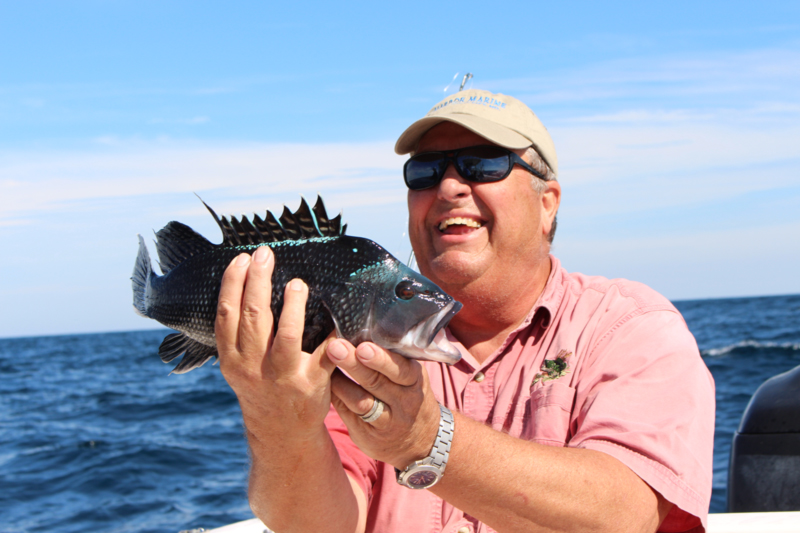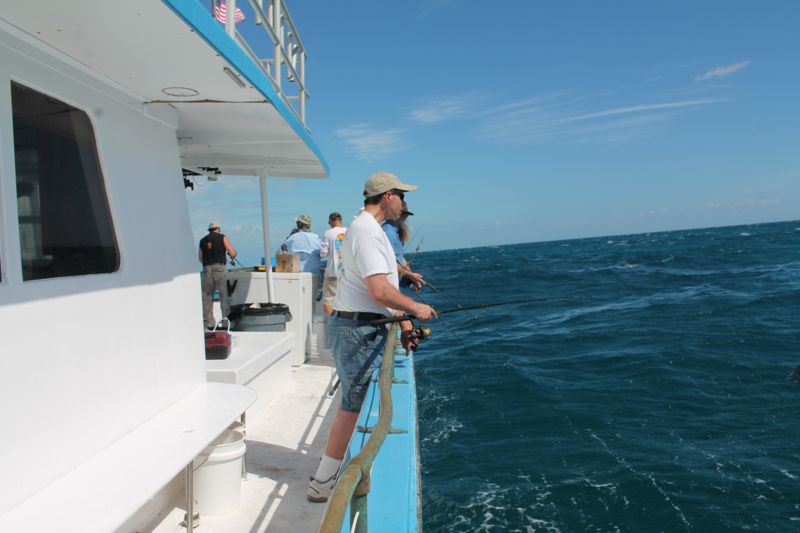A huge problem has wormed its way into marine fisheries management. We’re now on course to collapse several important fisheries. The culprit? NOAA’s Marine Resource Information Program (MRIP). Shamelessly high estimates have often caused undue economic distress to recreational fishing businesses. Now accelerated, decades of overestimates make stocks appear far more robust than they truly are. MRIP’s inclusion in scientific stock analysis will topple decades of restoration efforts by assigning quotas far higher than they would be. This effect has already begun on fluke (summer flounder.)

Even the Technical and Monitoring Committees — our nation’s best fisheries scientists — have recognized some of MRIPs catch estimates as wildly wrong and threw out some 2016/17 sea bass estimates. If similar estimates are not eliminated in 2020/21, we will surely witness an unfair tightening of sea bass regulation.
Private boat catch routinely shoots up by hundreds of thousands, a million, or even three million pounds! Yet, so long as the statistical formula is correct and approved by other statisticians, NOAA holds that the numbers MRIP produces must be correct.
Even if they aren’t.
If catch estimates assert vast numbers of anglers caught unimaginable amounts of fish, then there must have been a congruent number of boats. It’s unassailable: Where there is catch there must first be fishing. But fishermen witness boats fishing, not statisticians. NOAA has always been unwilling to trust what fishers advise, and it’s been my experience that statisticians would sooner give up their PhD than utilize fishermen’s knowledge of recreational catch.
For May and June of 2021 MRIP shows 248,870 anglers participated in private boat trips catching sea bass in Massachusetts. Those anglers were estimated to have caught 1,038,500 sea bass that weighed over two pounds apiece. That’s nearly half the entire coastwide annual quota caught in perhaps 30 to 35 days, in one state by private boats.
How many boats would that gigantic catch take to land? MRIP says 248,870 anglers did the catching. Divide that by 3.5 (as an average number of anglers per boat), which equals 71,105 boat trips. Divide again by 35 fishable days out of the period. You then have 2032 boats fishing every fishable day of the week. You’d think folks would marvel at the length and breadth of the fleet and make “OMG” drone videos.
They’re not.
Party/Charter corrected the For-Hire sector’s overestimates in the early 2000s. After that correction private boat landings began to climb and they haven’t stopped. Party/Charter catch data is hardly perfect, but it’s usually reasonable — way better than MRIP’s other data sets of shore anglers and private boats. In 2021 all for-hire boats from Cape Cod to Cape Hatteras caught 581,500 sea bass all year.
So, according to MRIP, in just a month and a half, Massachusetts recreational anglers on private boats out-fished the year’s catch of all of the professionally captained boats from Cape Hatteras to Cape Cod — by 1.3 million pounds.
That’s absolutely crazy.
And as for Maryland, where I’ve targeted sea bass for 42 years? Here MRIP shows 19,600 anglers fished on private boats for sea bass during May/June. I was only able to fish 30 days during this period in a 55foot partyboat. Divide 19,600 by 3.5 as an average number of anglers per boat, and divide again by 30 days. If MRIP is correct, there were 187 private boats fishing sea bass every fishable day in May/June. That’s like the White Marlin Open for 30 days but with smaller craft.

The very most we’ve ever seen in a bass-fishing fleet here is about 40 boats on the nicest day possible.
MRIP estimates Maryland for-hire boats caught about 8000 sea bass in the same period. Consensus among Maryland professionals is that private boats catch about 20 percent of our sea bass, which would be 2400 fish. Not 103,000, as MRIP holds. We’ve one coastal port that catches legal sea bass. We’re not wrong.
I especially want readers to know that NOAA’s catch estimate repairs always have catches going up, but never going down. From among hundreds that I know of, here are two clear examples of catch data rising despite having been too high to begin with. First, in Sept/Oct 2007 Maryland shore catch of summer flounder was first estimated at about 50,000 pounds. Because statisticians think private boat and shore anglers lie when asked about catch, MRIP recalibration increases put shore-caught summer flounder catch for that period now at 140,000 pounds.
Imagine tales of that surf blitz… had it happened. Legendary. But it didn’t happen.
Second, there’s the New Jersey March/April 2010 shore-caught tautog estimate of 73,000, an insanely high number that no one thought remotely possible. In 2012 the estimate was raised to 174,000. In a press release MRIP said it was proud of the estimate. In 2018 it was raised again, this time to 341,440 fish with an MRIP “recalibration.”
Oh, it’s fixed alright. Everything’s fine.
No angler should believe these estimates. Fewer and fewer in the management and fisheries science communities do. NOAA’s statisticians and top brass apparently like them, though. Stifling debate instantly at council and commission meetings, the Regional Administrator says “It’s peer reviewed.”
Indeed, statisticians are glad to show a collection of peer reviews by other statisticians illustrating the mathematical purity of the work — yet MRIP’s formulas obviously lead to estimates that couldn’t possibly be true.
Consider an analyst’s position. When the decision “how many fish can we safely catch?” comes, everyone turns to the work of stock analysts. They’re told that recreational catch data must be treated as though real. Therefore, if recreational anglers are catching large amounts of a species on a computer — even catches not a soul believes — to fit their scientific population model there must be vastly more of those fish in the ocean than had been previously thought. Inflated recreational catch, you see, makes it appear as though there are a lot more fish in the sea.
I did an analysis of the last three years of private boat sea bass catch by comparing on the water observations of for-hire skippers like myself against MRIP’s estimates. Where I calculated private boats landed 1,034,000 sea bass in all of 2021 between Cape Cod and Cape Hatteras, MRIP’s estimate was 4,400,000 fish higher and 8,556,000 pounds more. Mix numbers four times higher into population analysis and you get muck.
That muck, or what NOAA calls their “best available scientific,” pushes commercial quotas upward. Unlike recreational fish caught only on a computer, however, commercial quotas are indeed landed and sold.
Overfishing will first become obvious with summer flounder. Commercial quota hasn’t been caught since a massive 49 percent quota increase in 2019. Management is blaming it on covid. Commercial fishers left fully 25 percent of their fluke quota in the ocean these last two years. That should have made recreational fishing outrageously good.
But it didn’t.
When someone finally asks “where’d they go?” NOAA will show their work on who caught what. It will be recreational boats that overfished summer flounder. Trailer pirates will have wiped out fish faster than foreign factory ships of yore. Recreational fishers will be framed for a statistician’s crime by NOT COMPLAINING about recreational catch estimates.
I believe an “extended peer review” offers a path to repair. From Wikipedia: “Extended peer review is the process of including people and groups with experience beyond that of working academics in the processes of assuring the quality of research. If conducted systematically, this can lead to more reliable, or applicable, results than a peer review process conducted purely by academics.”
There are lots of scientists and managers — I’d say most actually — who have had enough of MRIP. If statisticians would include fisheries staff and fishermen in these peer reviews, I believe they’d soon get an uncomfortable earful. All anglers need to write their DC reps and state fisheries bosses and tell them MRIP needs an extended peer review.
Overfishing should have long since been controlled. Habitat repair and improvement; utilizing regulations’ effects on spawning production; these brute strengths of modern marine fisheries management remain unused as scientists and managers ponder the perpetual ping pong ball of recreational catch where no amount of regulation seems able to control private boats. Our whole system of fisheries restorations is stifled because proud statisticians cannot be bothered to listen to fisheries professionals.
I have no doubt fish and fishing can be made better than they’ve ever been. That won’t happen while management has MRIP for its eyes.
Regards,
Monty
- By Captain Monty Hawkins, of the Morning Star
Editor’s Note: To see a sample letter one might send to your representatives, visit Capt. Monty's fishing report. Scroll down to Monty’s 2/28/22 report, which includes an extended version of this writing along with a sample.